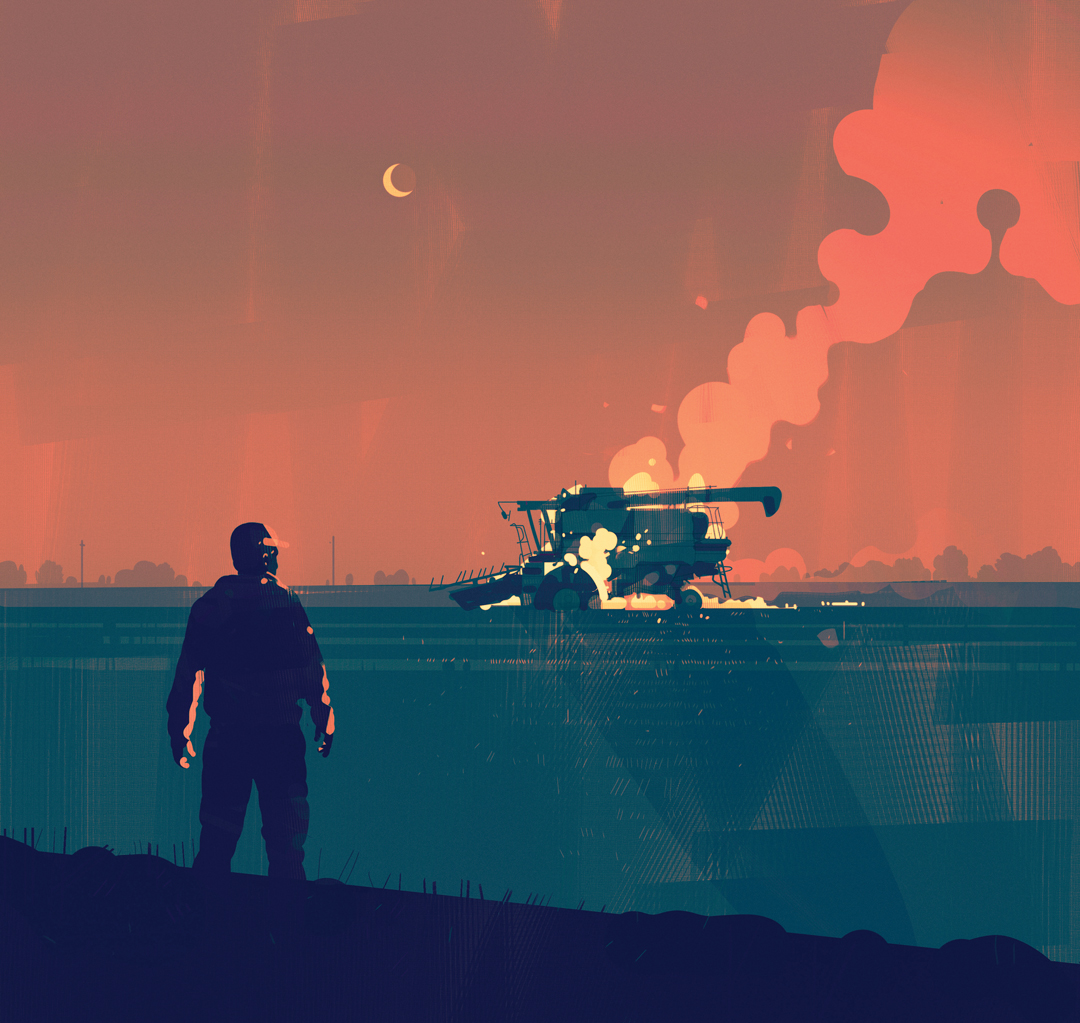FRIGHT NIGHT
BY TOBAN DYCK • ILLUSTRATION BY DARYA SHNYKINA
At dusk on Sept. 30, with about 100 acres of soybeans left to complete the 2023 harvest, our combine went up in flames.
The fire investigator would later tell us it was ignited by a worn-out bearing. Its proximity to a cluster of hydraulic hoses may have caused the flames to spread quickly, but that’s my assessment, not his.
The day of the accident, I was doing what I typically do during harvest season. Drive the grain truck, move the auger and conveyors, watch Instagram Reels and listen to true crime podcasts.
As I conveyed an eighth load of soybeans into bin number seven, dad combined the home half, our final field of the season. Our yard and half-mile driveway split the field into a 15-acre plot to the south and a 240-acre plot to the north. He worked on the north-south rows starting at the east end of the field, parallel and close to RD 22W in Manitoba’s R.M. of Stanley.
A safety conscious farmer, once the truck was emptied of soybeans, I lowered the bucket. Years ago, a hired hand drove from our bin area to the road with the truck box fully extended. It tore down a set of overhead powerlines, which fried the high-value appliances in what was then my parents’ house.
As I jumped into the cab, the telltale radiant glow of fire appeared in the distance through a shelterbelt of leafless trees. A large fire, by the looks of it. This is not an uncommon sight in the area. My neighbours enjoy building large bonfires. Heck, who doesn’t? And the orange flicker looked like it may have been coming from their yard.
Unconcerned but curious, I drove through our bin area, snaked past our house and onto the driveway. Along the south side of the lane, there’s a short stretch of shelterbelt, a curtain of vegetation that softens the seasonal punch of Prairie weather against our home. It blocked my view of the disaster in progress.
On the far side of the shelterbelt, I was alarmed to realize my neighbours had not lit a bonfire as I’d imagined. The combine my dad had been operating was clearly on fire. It was getting dark. I could see the flames were about one-and-a-half times larger than the combine itself. I could not see my dad.
That moment things changed for me. My casual demeanour on a day in which I took for granted things would happen at a dependable, untroubled pace changed in a millisecond. I became hyper focused and action ready.
I punched it, took that grain truck to its top speed and stormed onto the field from the driveway. I was now full animal. My instinct forced me to behave as though my dad might be in that combine and an act of heroism may be required.
As my brain attempted to process the tableau in front of me, the fire seemed huge, wild and unpredictable. I was struck by the realization that situations on a farm can change on a dime and that catastrophes this spectacular can occur whether you’re prepared for them or not.
As I got closer, dad’s silhouette came into view. He stood there with the lunch kit he’d saved from the fire, holding his smartphone at arm’s length, shooting video as his combine burned. He was fine.
The huge blaze, he told me, grew as quickly as a match lights when struck. He said he didn’t panic, but men of his generation would never admit such things. He remained in the cab long enough to disengage the rotor, stop and back up far enough to turn and drive away from the crop without destroying a single plant.
Fire crews came. The neighbours came. The fire continued for a while. As if systematically, it spread from one fluid reservoir to another, each one changing the colour and sound of the flames. In the already large fire, when the diesel tank lit up, it didn’t make a huge contribution to the spectacle, but when the tires blew, the world knew it. Each explosion was shockingly loud and shook the whole combine. When the cab glass burst, followed by the hopper sight window, hundreds of bushels of soybeans flowed over the charred seat, through the cab and onto the ground.
It was a grim sight; soybeans where the driver should rightly be seated. It gave me that strange chill you get when you witness something unnatural. The brightness of the flames did nothing to cheer the darkly unpleasant scene.
Along with dad’s lunch kit, our header was saved. That was it. The charred remains of our Case IH Axial-Flow 8010 sat on our field in full view for a long time. Friends and family came down to look at it. I took pictures. Our insurance broker came by. The fire investigator did his inspection.
The insurance claim process has been complicated, uncomfortable and eye-opening. As a farm journalist, it’s a topic I now feel I should write about.
We’re not alone in the loss of a combine. I have appreciated the stories others have shared with me in person and on social media about similar incidents on their farms.
It’s just a machine, we tell ourselves. We’re simply glad no one was hurt. These platitudes are true, but they are used to mask our feelings. I’ve been in the farming community long enough to know that when such an accident is witnessed by others, the victim is naturally self-conscious.
What did others think as they drove down RD 22W and saw our burnt combine? It sat in the field long enough for me to craft all sorts of narratives around what its presence might evoke in the minds of fellow farmers, neighbours and even Sunday drivers out for a country cruise. Maybe sympathy. Maybe empathy. Maybe nothing. Farmers must have speculated upon the reasons our combine burnt and theirs has not.
My dad was not in the cab. That is all that matters.
The day of the fire was followed by several days of rain. When the weather permitted us to resume harvest, we were ready for it. My neighbour offered his combine. We paired it with a rental and tackled the remaining 100 acres quickly and without incident.
Since then, we’ve purchased a replacement combine. It’s another, newer Case. I’m not yet familiar with its operation. Once the busy ag conference season slows down, I’ll spend some quality time with the manual.
The night of the fire, as quickly as I was jolted into a hybrid of instinct and panic, the realization my dad was OK brought me back to a place where he and I could share a laugh, albeit a nervous one, about the situation. We were safe, most of the crop was in the bin and we knew we’d have a story to tell.
Toban Dyck farms about 1,200 acres of soybeans, cereals and canola with his father and is the founder of Burr Forest Group, an agricultural communications firm.







Comments